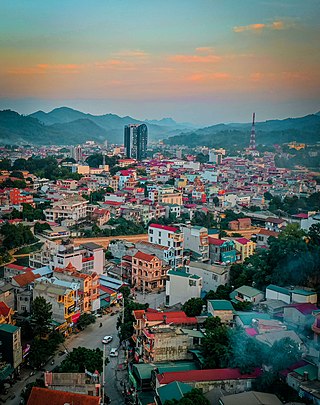Articles related to Vietnam and Vietnamese culture include:

Cao Bằng ( ) is a city in northern Vietnam. It is the capital and largest settlement of Cao Bằng Province. It is located on the bank of the Bằng Giang river, and is around 30 kilometres (19 mi) away from the border with China's Guangxi region. According to the 2019 census, Cao Bằng City has a population of 73,549 people.

Phong Nha-Kẻ Bàng is a national park and UNESCO World Heritage Site in the Bố Trạch and Minh Hóa districts of central Quảng Bình Province in the North Central Coast region of Vietnam, about 500 km south of Hanoi. The park borders the Hin Namno National Park in Khammouane Province, Laos to the west and 42 km east of the East sea from its borderline point. Phong Nha-Kẻ Bàng National Park is in a limestone zone of 2,000 km2 in Vietnamese territory and borders another limestone zone of 2,000 km2 of Hin Namno in Laotian territory. The core zone of this national park covers 857.54 km2 and a buffer zone of 1,954 km2.

Quảng Bình is a southern coastal province in the North Central Coast region, the Central of Vietnam. It borders Hà Tĩnh to the north, Quảng Trị to the south, Khammouane of Laos to the west and the East Sea to the east.

Nomascus is the second-most speciose genus of the gibbon family, Hylobatidae. Originally, this genus was a subgenus of Hylobates, with all individuals considered to be one species, H. concolor.

Trùng Khánh is a district (huyện) of Cao Bằng province in the Northeast region of Vietnam.

The Hainan black-crested gibbon or Hainan gibbon, is a Critically Endangered species of gibbon found only on Hainan Island, China. It was formerly considered a subspecies of the eastern black crested gibbon from Hòa Bình and Cao Bằng provinces of Vietnam and Jingxi County in Guangxi Zhuang Autonomous Region, China. Molecular data, together with morphology and call differences, suggest it is a separate species. Its habitat consists of broad-leaved forests and semi-deciduous monsoon forests. It feeds on ripe, sugar-rich fruit, such as figs and, at times, leaves, and insects.

Paris By Night 91: Huế, Sài Gòn, Hà Nội is a Paris By Night program produced by Thúy Nga that was filmed at the Terrace Theater at the Long Beach Convention and Entertainment Center on January 12, 2008 and January 13, 2008.

Paris By Night 79: Dreams is a Paris By Night program produced by Thúy Nga that was filmed at the San Jose Center for the Performing Arts, on August 20, 2005. The show was MC'ed by Nguyễn Ngọc Ngạn and Nguyễn Cao Kỳ Duyên.

Paris By Night 77: 30 Năm Viễn Xứ is a Paris By Night program produced by Thúy Nga that was filmed at the Terrace Theater in the Long Beach Convention and Entertainment Center on March 5, 2005. It was released to DVD on April 28, 2005, two months later, just in time 2 days before the 30th anniversary of the Fall of Saigon on April 30, 2005.

The southern white-cheeked gibbon is a species of gibbon native to Vietnam and Laos. It is closely related to the northern white-cheeked gibbon and the yellow-cheeked gibbon ; it has previously been identified as a subspecies of each of these.

Paris By Night 59: Cây Đa Bến Cũ is a Paris By Night TV program produced by Thúy Nga that was filmed at CBC Toronto Studios - Studio 40, Toronto, Canada in 2000. Nguyễn Ngọc Ngạn was the master of ceremonies for this program. This was a volume in the series Paris By Night that did not include a comedy skit or have something known as a "Hài Kịch". The DVD version of Paris By Night required only a single disc, while the VHS version is a three-tape set. This program had no audience. On April 25, 2019, the show was uploaded in its entirety to the official Thúy Nga Productions YouTube channel.
The 5th Military Region of Vietnam People's Army, is directly under the Ministry of Defence of Vietnam, tasked to organise, build, manage and command armed forces defending the South Central Vietnam include the Tây Nguyên and southern central coastal provinces.

Paris By Night 100: Ghi Nhớ Một Chặng Đường is a Paris By Night program produced by Thúy Nga Productions that was filmed at the Planet Hollywood Theatre for the Performing Arts in Planet Hollywood Resort & Casino from July 3–4, 2010 and released DVD on October 7, 2010. The show was hosted by emcees Nguyễn Ngọc Ngạn and Nguyễn Cao Kỳ Duyên.

Paris By Night 99 – Tôi Là Người Việt Nam is a Paris By Night program produced by Thúy Nga Productions that was filmed at Knott's Berry Farm on 16 and 17 January 2010 and released DVD from 9 April 2010. The show was hosted by Nguyễn Ngọc Ngạn, Nguyễn Cao Kỳ Duyên and Trịnh Hội.
Hợp ca tranh tài was a Vietnamese reality talent contest that made its debut on VTV3 in Vietnam on February 24, 2012. There were about twelve episodes scheduled to air.
Ná-Meo is a language of northern Vietnam, spoken by the Mieu people. Nguyen (2007) believes Na Meo may be a Hmongic language closest to Qiandong Miao.
Love Case is a 2008 Vietnamese telefilm adapted from Hồ Văn Trung's July 1941 novel Cư kỉnh (居璟). The film was produced by Ho Chi Minh City Television and directed by Võ Việt Hùng.

The 23rd Vietnam Film Festival was held from November 21 to November 25, 2023, in Da Lat City, Lâm Đồng province, Vietnam, with the slogan "Building a Vietnamese film industry rich in national identity, modern and humane".















